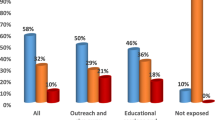Abstract
Objective: This study evaluates the effectiveness of a set of information, education, and communication (IEC) strategies designed to increase the awareness of danger signs in pregnancy, delivery, or the postpartum period among pregnant or recently pregnant women. Methods: Three IEC programs were implemented in 4 regions of southwestern Guatemala between April 1997 and May 1998: (1) a clinic-based program involving the training of health providers in prenatal counseling and the provision of educational media to clients; (2) a community-based strategy consisting of radio messages regarding obstetric complications; and (3) educational sessions conducted through women's groups. Three surveys were conducted. In 1997, 637 pregnant women were interviewed at clinics where the interventions had been implemented. In 1998, 163 pregnant women using a subset of the same health clinics were interviewed. In 1999, a population-based survey of 638 pregnant and postpartum women was conducted. Using logistic regression, we model awareness of danger signs as a function of sociodemographic characteristics, prenatal care utilization, and IEC interventions. Results: Among women using health clinics, the likelihood of having heard of danger signs nearly tripled between 1997 and 1998, when the clinic interventions were fully implemented. In 1999, those who had heard radio messages or participated in women's groups were, respectively, 3 times and 5 times more likely to have heard of danger signs in pregnancy. Conclusions: Safe motherhood programs can effectively increase knowledge of danger signs through clinic- and community-based educational strategies.
Similar content being viewed by others
REFERENCES
Rosenfield A, Maine D. Maternal mortality-a neglected tragedy:Where is the M in MCH? Lancet 1985;2:83–5.
Bergtrom, S. Is there an "M" in perinatal medicine? J Trop Pediatr 1991;37:89–90.
Maine D. Safe motherhood programs: Options and issues. New York: Columbia University, 1991.
World Health Organization. Mother-baby package: Implementing safe motherhood in countries. Geneva: World Health Organization (WHO/FHE/MSM/94.11), 1996.
Koblinsky MA. Healthy pregnancy and childbearing. In: Haaga J, Tsui A, Wasserheit J, editors. Reproductive health in developing countries. Washington, DC: National Academy Press, 1997.
Rooks J, Winikoff B, Bruce J. Technical summary: Seminar on "Reassessment of the concept of reproductive risk on maternity care and family planning service," February 12–13, 1990. New York: The Population Council.
Vanneste AM, Ronsmans C. Can a single visit during pregnancy identify women in need of special care during labour and delivery? Dissemination workshop on findings from safe motherhood research & new challenges in the maternity care program in matlab, Bangladesh, 1997.
Rooney C. Antenatal care and maternal health: How effective is it? A review of the evidence. Geneva: World Health Organization (WHO/MSM/92.4), 1992.
Vanneste AM, Ronsmans C, Chakraborty J, De Francisco A. Prenatal screening in rural Bangladesh: From prediction to care. Health Policy Plann 2000;15(1):1–10.
Maine D, Rosenfield A. The safe motherhood initiative: Why has it stalled? Am J of Pub Health 1999;89(4):480–2.
Campbell OMR, Koblinsky M, Taylor P. Off to a rapid start: Appraising maternal mortality and services. Int J Gynecol Obstet 1995;48(Suppl):S33–S52.
Bello Gummi F, Hassan M, Shehu D, Audu L. Community education to encourage use of emergency obstetric services,Kebbi State, Nigeria. Int J Gynecol Obstet 1997;59(Suppl. 2):191–200.
Olaniran N, Offiong S, Ottong J, Asuquo E, Duke R. Mobilizing the community to utilize obstetric services, Cross River State, Nigeria. Int J Gynecol Obstet 1997;59(Suppl. 2):181–9.
Mother Care's Community Assessments. MotherCare Matters 2000;8(3–4):1–17.
Piotrow PT, Kincaid DL, Rimon JG II, Rinehart W. Health communication lessons from family planning and reproductive health.Westport, CT: Praeger, 1997.
Ministry of Public Health and Social Assistance (MSPAS). Maternal mortality study. Guatemala: MSPAS, 1989.
Molina S. Mothercare II Guatemala: Informe de 5 Años 1994–1999. Guatemala City: Mother Care, 1999.
Hurtado E. The MotherCare/Guatemala Project. Overview of IEC strategies and lessons learned. Guatemala City: Mother-Care, 1999.
Hurtado E. Audiencias de cuñas de radio sobre señales de peligro en el embarazo en el altiplano de Guatemala. Project final report, MotherCare, 1998.
Hurtado E. Sesiones participativas con grupos de mujeres. Informe de Evaluación del Proyecto MotherCare/Guatemala. Project final report, MotherCare, 1998.
MotherCare's integrated efforts for improving maternal health care-examples from three demonstration projects. Mother-Care Matters 1997;6(4):10–5.
UNICEF. Improving child survival and nutrition. Dar es Salaam:The JointWHO/UNICEFNutrition Support Program in Iringa, Tanzania, 1989.
STATA User's Guide. Release 7. College Station, TX: Stata Press, 2001.
24. Bailey P, de Bocaletti E, Holland H. Using hospital data to monitor utilization and referral patterns of women with obstetric complications in Guatemala. Unpublished paper, 2001.
Population Reference Bureau. Making pregnancy and childbirth safer. Washington, DC: Measure Communication Policy Brief, 2000.
Berg C, Atrash H, Koonin L, Tucker M. Pregnancy-related mortality in the United States, 1987–1990. Obstet Gynecol 1996;88(2):161–7.
Author information
Authors and Affiliations
Rights and permissions
About this article
Cite this article
Perreira, K.M., Bailey, P.E., de Bocaletti, E. et al. Increasing Awareness of Danger Signs in Pregnancy Through Community- and Clinic-Based Education in Guatemala. Matern Child Health J 6, 19–28 (2002). https://doi.org/10.1023/A:1014360015605
Issue Date:
DOI: https://doi.org/10.1023/A:1014360015605




